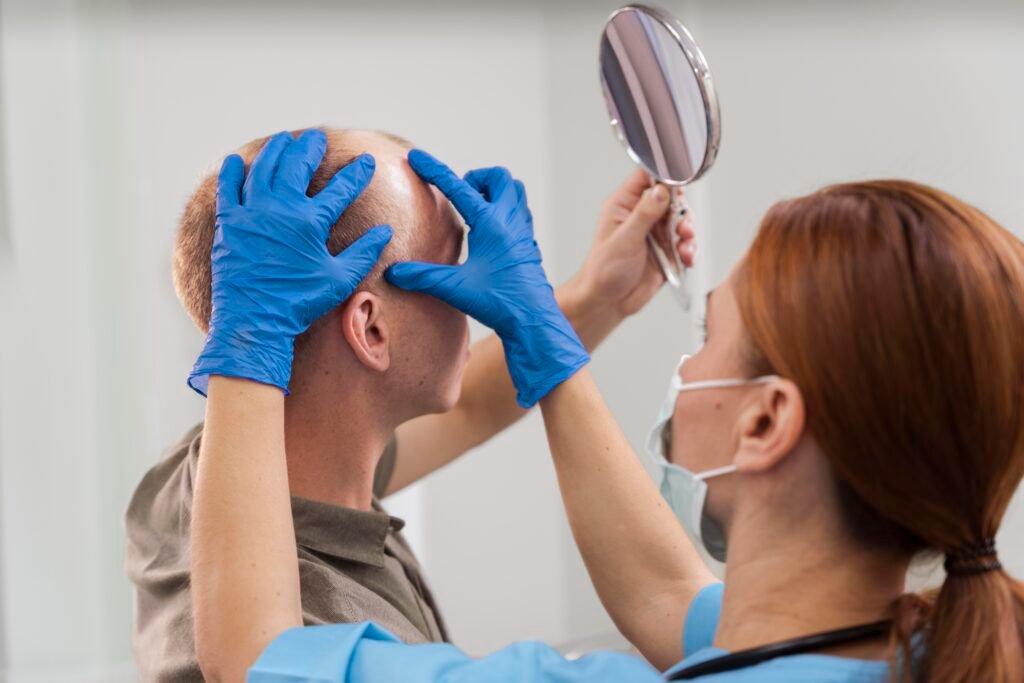
FUE vs FUT Hair Transplant – Millions of men and women around the world struggle with hair loss at some point in their lives.
It not only changes a person’s appearance but also affects self-confidence and mental well-being. Modern medical science now offers a reliable solution—hair transplant surgery.
Among the different methods available, two popular techniques are:
FUE (Follicular Unit Extraction)
FUT (Follicular Unit Transplantation)
Both methods give natural-looking results, but they are different in terms of the procedure, recovery, cost, and outcome. In this blog, we will explain what FUE and FUT are, their pros and cons, and help you understand which one might be better for you.
What is an FUE Hair Transplant?
FUE stands for Follicular Unit Extraction. In this method, doctors remove single hair follicles (tiny roots of hair) from the donor area, usually the back or sides of the scalp. The extracted hair follicles are carefully implanted into the bald or thinning spots.
Unlike older techniques, FUE does not involve cutting out a strip of skin. Instead, it uses very small punches, leaving behind only dot-like marks that are almost invisible. Because of this, many people who like to keep short hair prefer FUE.
Advantages of FUE:
Hair looks natural because follicles are placed carefully.
Minimal scarring with tiny dots that are hard to notice.
Faster healing—most patients recover in 7 to 10 days.
Less pain during and after the surgery.
Flexible hairstyles, even short cuts, are possible.
Disadvantages of FUE:
Time-consuming because hairs are taken out one by one.
Usually costs more than FUT.
May require multiple sessions for people with heavy hair loss.
What is FUT Hair Transplant?
FUT stands for Follicular Unit Transplantation. This is one of the oldest and most commonly used techniques. In FUT, doctors remove a thin strip of skin with healthy hair from the back of the head. The removed strip is carefully separated into tiny hair follicle units under a microscope, which are then gently implanted into the thinning or bald areas.
Advantages of FUT:
More hair grafts can be transplanted in one sitting.
Usually more affordable compared to FUE.
Long-lasting and natural results.
Higher survival rate of grafts since they are handled under a microscope.
Disadvantages of FUT:
Leaves a straight-line scar at the back of the head.
Recovery takes longer—around 2 to 4 weeks.
More discomfort after surgery.
Not suitable for people who like very short hairstyles.
Key Differences Between FUE and FUT
Here are the main points that separate the two techniques:
Method of Extraction:
FUE: Individual hair follicles are removed.
FUT: A strip of skin is cut, and hair follicles are separated from it.
Scarring:
FUE: Leaves tiny dot scars that are barely visible.
FUT: Leaves a long scar that may show if hair is very short.
Recovery Time:
FUE: Faster recovery (7–10 days).
FUT: Slower recovery (2–4 weeks).
Pain and Discomfort:
FUE: Less invasive, so less pain.
FUT: More discomfort due to stitches.
Number of Grafts:
FUE: Good for moderate hair loss.
FUT: Suitable for advanced hair loss.
Cost:
FUE: More expensive because it takes more time and uses advanced tools.
FUT: Less expensive and more budget-friendly.
Which One Should You Choose?
The choice between FUE and FUT depends on your personal situation and needs:
Stage of Hair Loss:
FUE works well if you have mild or medium hair loss.
FUT is better for advanced hair loss since it provides more grafts in one session.
Scarring Concerns:
If you want to avoid visible scars, FUE is the better option.
FUT will leave a linear scar that may limit short hairstyles.
Budget:
FUT is more affordable.
FUE usually costs more but offers faster recovery and less scarring.
Recovery Time:
FUE heals quicker, so you can return to normal activities sooner.
FUT takes longer to heal because of stitches.
Future Plans:
FUE preserves more donor hair for future transplants.
FUT is good if you want maximum coverage in one procedure.
Recovery and Aftercare Tips
No matter which method you choose, proper aftercare is important for good results.
Right After Surgery:
Keep your scalp clean as instructed by your doctor.
Do not touch or scratch the transplanted area.
Sleep with your head elevated to reduce swelling.
Medicines:
Take antibiotics and painkillers as prescribed.
Use special sprays or shampoos if recommended.
Activity Restrictions:
Avoid heavy exercise, swimming, or sun exposure for 2 weeks.
Do not smoke or drink alcohol since it slows healing.
Healing Timeline:
FUE: Most people heal within 7–10 days.
FUT: Healing may take 2–3 weeks.
Long-Term Care:
New hair starts growing after 3–4 months.
Full results are usually visible after 9–12 months.
Expert Recommendations
Every patient is different. Factors like age, stage of baldness, hair density, health, and budget should be considered before choosing a method. This is why it’s essential to meet an experienced hair transplant doctor. They can examine your scalp and help you decide the treatment that suits you best.
Conclusion
Both FUE and FUT hair transplants are effective ways to restore natural-looking hair and confidence.
FUE is better if you want a quick recovery, no visible scars, and flexibility with hairstyles.
FUT is a good choice if you need many grafts in one sitting and want a more cost-effective option.
The right choice depends on your personal goals and your doctor’s advice. Whichever method you choose, remember that when done by a skilled surgeon, both FUE and FUT can provide natural, long-lasting results and help you regain your self-confidence.

